

By J. Sharon Batteate
Camouflage, or protective coloration, in horses and other animals has taken many forms. Before proceeding into the types of striping seen in domestic horses today, some background information on camouflage may be of interest. In general, animals from forest or woodland environments tend to be darker, often with sections of the coat forming into spotted or striped patterns which mimic the effect of light filtering through trees. Animals from desert environments tend toward the yellowish, tan, or red hues, often with an agouti pattern in which each individual hair is striped or banded (rather than entire sections of the coat being striped), so that the animal now appears a non-striped, single color (monochrome), which blends better with sandy soils. Generally, there seems to be a tendency toward the non-striped agouti/monochrome coloration. Animals also migrate into different environments from which the root stock originally evolved. In these cases, the adults may eventually evolve and develop protective coloration to match their surroundings, but the young are often still born with the original primitive patterns from which they evolved. An example of this is the tapir, a living relative of the horse. Adult tapirs appear non-striped, but the young are born with light stripes on the body. Young lions are born with spotted and striped patterns, but become single/monochrome colored when they mature. Similarly, sometimes horse foals are born with primitive patterns and striping, which they loose as they mature.
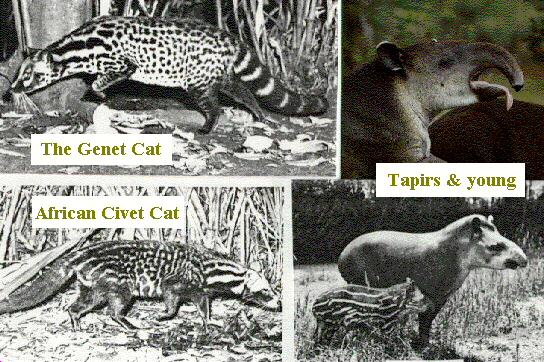
Striping is believed to be the most ancient form of camouflage, and is believed to precede both spotted and monochrome type pattens. A striped appearance can be caused in several ways. One is by the clumping of darker pigmented areas into streaks, as seen in the stripes of tabby cats and tigers, and also in the dorsal stripes and barring on the legs of donkeys and dun factor horses. A striped appearance can also be achieved by the introduction of lighter or white bands of hair, as seen in zebras, as seen in nyala, okapi, and other types of antelopes, and in some roan horses.

Spotting patterns are produced from the disintegration or breaking up of stripes. Often spots are clearly arranged in rows, so you can still see the pattern of the original stripe. Civet cats are good examples of this, and often have stripes on the head, but spots on the body (see previous photo). In some leopard appaloosa horses, the spots also seem to form broken up stripes. The Quagga, an extinct form of zebra, was characterized by having stripes primarily only on the head and neck. On the body, the stripes were broken down into a wavy or mottled pattern, and then finally became a reddish brown monochrome pattern.
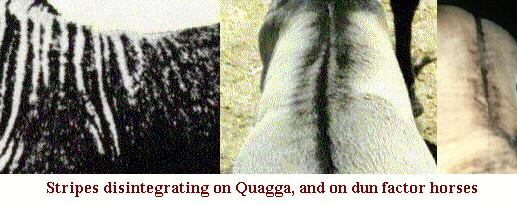
Monochrome and agouti like patterns result from the further breakdown of spots and stripes, so the body of the animal now appears to be mostly a single uniform color, although the face and back may still show some evidence of mottling or striping. Abyssinian cats are good examples of this process, as well as the above mentioned Quagga. Most of our horses today also exhibit monochrome type patterns, although on dun factor horses, some of the primitive striping still remains on the legs and down the back. The rest of the body, however, has gone the way of the Quagga, with any primitive striping having disintegrated into a monochrome pattern.

Another ancient camouflage technique is countershading. The animal is colored darker along the topline, and paler below, in order to counteract shadows caused by natural overhead light (which lights the top but causes shadows on the underside making the animal look three dimensional). Even on Zebras, the stripes are widest on the back, and smaller as they move toward the underside, so they exhibit countershading as well as disruptive striping for camouflage. In horses, the darker topline seen on mahogany bays and in the "seal brown" patten, and the colored back and sides, but almost white belly of the "blond sorrel" pattern, are examples of countershading. There have been no studies that I know of, to determine if one or several different genes may be involved in producing these different countershading patterns. "Mealy" (also called Pangare') may produce the blond sorrel, mealy muzzled bay and seal brown countershading patterns. "Sooty" (also called Smutty) may produce the sooty chestnut and palomino, smutty buckskin and dun, and mahogany bay and brown, countershading patterns.


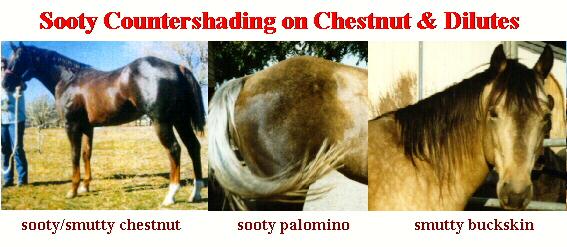
There is not much genetic information available on striping for horses, but in mice, there are at least 6 different locus which produce striping patterns (usually called mottling in mice). At the "A" (Agouti) locus, striping has appeared in viable yellow, mottled agouti, and agouti suppressor mice. At the "C" locus, striping has appeared in chinchilla mottled mice. At the "P" locus, striping has appeared in pink eyed mottled and p unstable mice. Striping has also appeared in mice at the "Silver" locus, and "Pearl" locus. Striping also appears at the "Mo" locus (responsible for Mottled, Blotchy, Dappled, Brindle, and Tortoiseshell patterns), and the nearby "Ta"(Tabby) locus. Whether any of these genes may be similar and account for striping patterns in horses remains to be determined.
In 1988 Mary Jagow of Silver Cliff, Colorado, began organizing the International Striped Horse Association in order to collect information and register horses with striped patterns, and to study the various striping patterns in horses. The registry plans to catalog the unique striping patterns found among strains of domestic horses, with each breed having a separate code. Mary Jagow, (719) 783-2683, can be reached at PO Box 209, Silver Cliff, CO 81249. They are currently working with four different types of striping ---- The registry was closed in 1999.
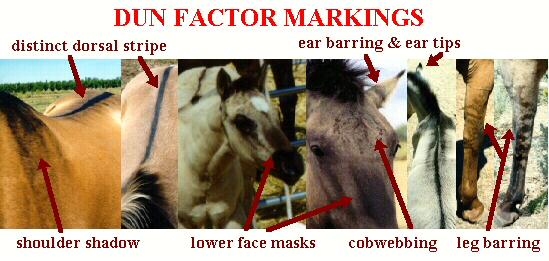
This is the type of primitive striping down the top of the back (also called dorsal stripe, spinal stripe, list, eel stripe, line back), accompanied by barring on the legs (also called leg bars, tiger, or zebra stripes), that is often associated with "dun" horses. The stripe down the back may be the remnant of a dorsal "mane", which the nyala antelope has to this day. This type of striping is often referred to as "dun factor markings" or "zebra markings." Most feel both the striping and dilution are a result of the same gene. However, there have been reported cases of "dun factor markings" without dilution. Most of these cases are probably mistaken examples of seal brown (darker) duns, or of countershading striping, which is not commonly recognized, and is often confused with dun factor markings. However, if some cases of dun factor markings without dilution are confirmed thru a study, it would mean the striping is probably actually inherited separately from the "D" dilution gene, but is somehow closely linked, for they are usually inherited together. The Dun factor gene changes black and dark brown into one of the many grulla shades (gray or brownish gray in which each hair is gray, not a mixture of white and dark hair which also looks gray). Various shades of bay become various shades of dun (if its a yellow body with black points, some people think of the color as buckskin). Sorrels and Chestnuts become apricot or red duns (some people call these colors claybank duns). Click here to see dun factor foal coat colors. Use Back Button (top of browser window) to return to this article from the link location.
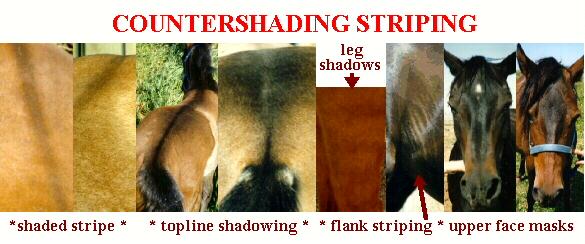
A number of horses with the sooty/ smutty type of countershading pattern will also exhibit a form of striping. Some countershaded horses are so dark along the topline, that any sign of striping would be difficult to see. However, in some lighter seal browns, mahogany bays, smutty buckskins, etc. a form of striping along the topline can be seen that is different from Dun Factor striping. Sometimes the stripe is almost as distinct as a dun factor type stripe, but usually the stripe is more of a shaded stripe, sometimes only a partial stripe, and is usually not associated with leg barring. I have seen some cases of countershading striping that also have a faint leg shadowing that is best seen if shaded from direct sunlight, and is thus usually missed, and is very difficult to photograph. It is not the same as the barring seen on the legs of dun factor horses. Countershading striping does not have to be accompanied by a dilution as the dun factor type usually is. Sometimes the flank areas and neck areas show faint striping that can be seasonal. The dapple pattern may also break the countershaded areas up into streaked as well as splotched patterns. If foals are born red bay with this type of striping down their back, they usually mature mahogany bay or dark bay. Some retain the countershading stripe, but most seem to loose it as they mature, in contrast to the dun factor type of striping discussed above, which is permanent. Foals born a smokey pale gray color with countershading striping, will usually mature brown or black. They are often mistakenly registered as grulla. Foals born sorrel with countershading striping down their back, will usually mature a darker shade of chestnut. Click here to see countershading foal coat colors. Use Back Button (top of browser window) to return to this article from the link location.

Not all roans exhibit striping. Roan (varying amounts of white hair mixed into haircoat, except on the face, lower legs, mane, and tail) and Roaning (a ticking of white hairs in the coat, often originating in the flanks or top of the tail) seem to be genetically distinct. Roan has been assigned to the "Rn" locus as a dominant gene. Roaning (white ticking, rabicano) has had no studies done that I know of. Some have said it may be a variation of the "sabino" spotting pattern, or it may turn out to have its own locus.
In one type of Roan Striping, there appears to be faint thin vertical stripes on the sides of the ribs in which the white hairs do not appear. It is usually accompanied by a coon/squaw/skunk tail showing horizontal bands of striping at the top of the tail. This type usually seems to be associated with roaning/rabicano types of roans. Sometimes the pattern is very minimal, with only a sprinkling of hairs in the flank and at the top of the tail.
We also see another type of striping in not only roan, but also in appaloosa, and sometimes gray horses. They don't have bands of striping in the tail, and the stripes over the ribs seem to be broader, similar to stripes seen over the ribs of some dun factor horses. Thus, this type of roan striping may eventually prove to be the interaction of roan with other types of primitive striping that have partially disintegrated.
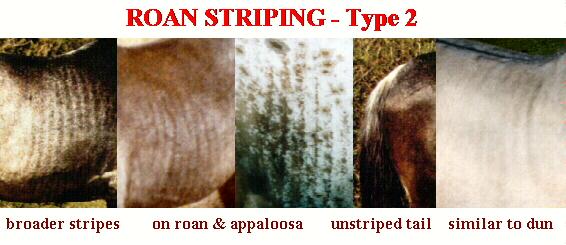
Brindle seems be the rarest stripe variation in horses. Brindle also appears in dogs and cattle, although apparently due to different causes. Some dogs only exhibit slight brindling, others are profusely marked. The origin in horses is unknown, although examples have reportedly been found in Arabians, Thoroughbreds, Mustangs, Quarter Horses, Bavarian Warmbloods, Spanish horses, horses in the Netherlands, and one specimen in Russia was considered so unique that when he died he was preserved and put in a museum. For more information on the brindle pattern, click highlighted type to visit the site for Brindle Horses at http://members.aol.com/brindlehos/index.htm
This article was originally published in 4-BEAT MAGAZINE (SPRING 1993) vol.3-no.1,pg 30. 4-BEAT MAGAZINE, PO Box 1079, Three Forks, MT 59752.
This article was revised for this web site © Feb 1997, J. Sharon Batteate, (209) 477-1536, PO Box 8535, Stockton, CA 95208 USA. e-mail [email protected]
The pictures and information on this site are for informational purposes, in order to educate people on various forms of striping and primitive patterns. The pictures and information on this site are copyrighted. All rights reserved. No part may be reproduced, stored in a retrieval system, or transmitted in any form or by any means, electronic, mechanical, photocopying, recording, or otherwise, without the prior permission of the copyright holders.